- Introduction
- The Setup
- Formal Organization
- The Musical Role of Spatialisation
- Spatialized Writing
- Density Variation
- Circular Motion
- Foreground / Background
- Zig-Zag
- The Use of Reverberation
- References
Pierre Boulez sur B.R.A.H.M.S
- Fiche œuvre de Dialogue de l'ombre double (version originale pour clarinette et bande)
- Biographie
- Parcours de l'œuvre
- Catalogue
- Ressources
Voir tous les mots-clefs
Introduction
The original inspiration for this composition comes from a specific scene in the play Le Soulier de Satin written in 1924 by Paul Claudel. This is a work that Pierre Boulez came in contact with on the occasion of Jean-Louis Barrault’s production at the Comédie Française. The action in Le Soulier de Satin takes place mostly in Spain but also many other places (Mogador, Americas etc.). There are many references to distant places and times, but few to “here and now”. The work is a sort of “zig-zag” of place and time.
The title of Boulez’s work comes from a particular point in Claudel’s play : the second day, scene 13 entitled L’Ombre Double (literally : the double shadow) because of the shadow of a man and a woman together projected onto a wall. So the inspiration for Boulez comes from this specific scene, not the work as a whole. In the play the double shadow is treated as a single character. In Dialogue de l’Ombre Double a solo live clarinet (called clarinette première) placed in the middle of the hall dialogs with a kind of shadow of itself. The shadow is the pre-recorded clarinet (called “clarinette double”) which is spatialized over a six point loudspeaker system placed on the periphery of the hall. The audience is placed between the solo clarinet and the loudspeaker system.
The Setup
Ideally, the performer is placed in the middle of the concert hall surrounded by the audience which in turn is surrounded by a group of six equidistant speakers over which the transitions are played.
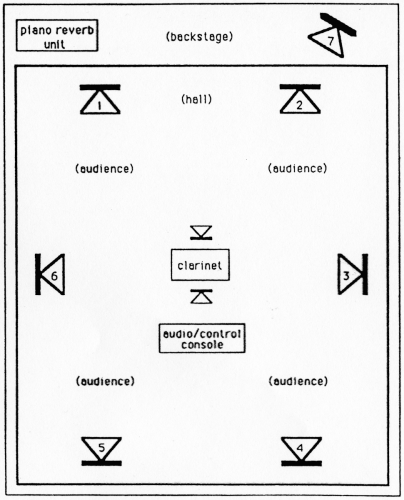
However, since all halls are not well suited to placing the performer in the center, it may be necessary to place the performer on a traditional stage instead.
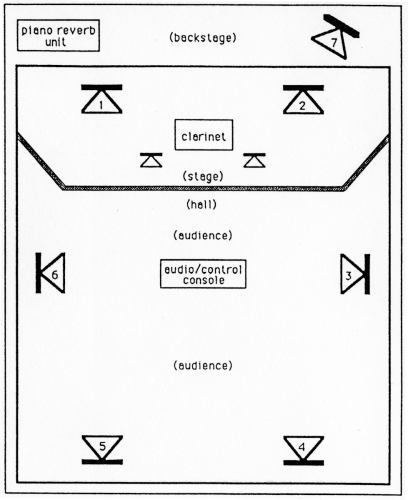
In order to heighten the contrast between the live strophes and the recorded transitions, special lighting may be used to illuminate the performer only during the strophes - the live portions - he plays live on stage.
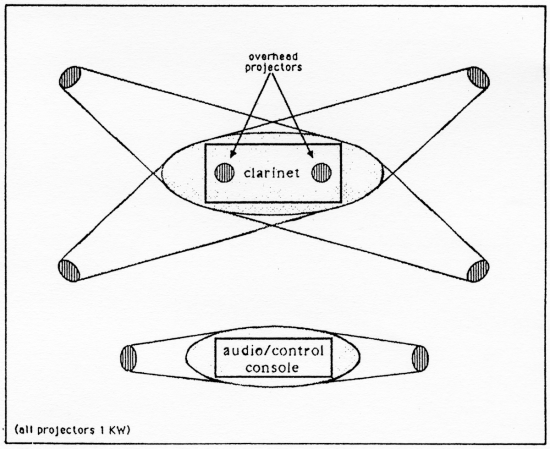
All figures from “Technical Instructions” booklet accompanying the score (Pierre Boulez “Dialogue de l’ombre double” © Copyright 1985 by Universal Edition A.G., Wien/UE 18407)
The Strophes
During the strophes, the clarinet may need to be amplified with the aid of a microphone and two speakers placed near the performer. If the acoustics of the hall are excessively dry, the clarinet’s sound is reverberated slightly.
During Strophe II, Strophe III and Strophe V in the version in Roman numerals and Strophe 1, Strophe 3 and Strophe 4 in the version in Arabic numerals, the live clarinet’s sound is transformed with the aid of a piano, whose right pedal is pressed down permanently so that the strings can vibrate freely. (See Figure below.)
This transformation works in the following way:
The amplification microphone picks up the live clarinet’s sound which is sent to a speaker placed under the piano.
The sound coming out of the speaker makes the freely vibrating strings of the piano resonate.
A microphone placed over the strings picks up the resonating strings’ sound which is then sent to the two speakers used for normal amplification.
Notice in the first two setup figures that the piano should not be visible to the audience.

Figure from Technical Instructions booklet accompanying the score (Pierre Boulez “Dialogue de l’ombre double” © Copyright 1985 by Universal Edition A.G., Wien/UE 18407).
The Transitions
The clarinet should be recorded on track one of the tape. The transitions are played back through six equidistant speakers (referred to as speakers 1 to 6) surrounding the audience and one speaker placed outside the circle (referred to as speaker 7). This last speaker, used only at the end of the last tape section of the piece, should sound distant and may therefore be placed outside the hall. Following the cues marked in the score, the pre-recorded clarinet sounds are to be sent around the hall from one speaker to another giving the listener the impression that the sounds are moving in physical space. Hereafter, this will be referred to as “spatialisation”.
In Dialogue de l’ombre double two kinds of spatialisation are used:
continuous: the sound moves smoothly from speaker to speaker.
discrete: the sound moves abruptly from speaker to speaker.
Depending on the means available, the spatialisation may be performed in one of two ways:
manually: the level of each speaker is controlled by the individual potentiometers of a small mixing console.
automatically: the second track of the tape should contain a code that will be sent to the control computer in order to trigger the level changes automatically in synchrony with the cues marked in the score.
Equipment Setup
The figure below shows the complete electronic setup necessary for a performance of Dialogue de l’ombre double. The equipment surrounded with a dotted line (the VCA control unit, the control computer and the SMPTE decoder) is necessary only if the spatialisation is to be done automatically.
NB : The figure is taken from the technical documentation edited in 1992. The tape recorder function can be replaced by any computer multitrack recording and playback technology ; the VCA unit by any level automation system coupled to a time code device.
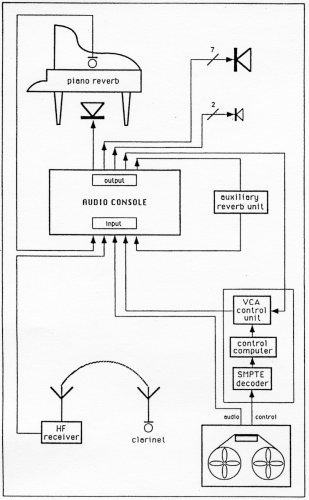
Figure from Technical Instructions booklet accompanying the score (Pierre Boulez “Dialogue de l’ombre double” © Copyright 1985 by Universal Edition A.G., Wien/UE 18407).
Cue Notation
Changes in spatialisation are indicated in the score using cue numbers. Accompanying each cue number is a graphical indication showing the level for each speaker.

As mentioned previously, the spatialisation can be done automatically (the preferred method) or manually. Indications for both types of spatialisation cues are shown in the score fragment below. Squares enclosed automatic cues. Circles enclose manual cues. When only circled cues appear, they apply to both automatic and manual spatialisation.
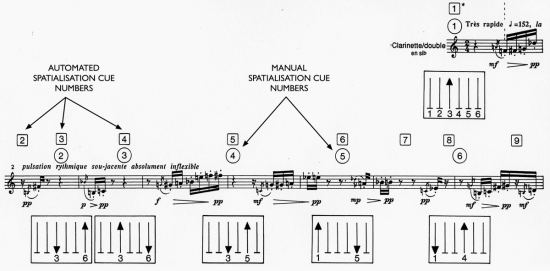
Formal Organization
From a formal point of view the piece consists of a Sigle Initial, six Strophes linked by five Transitions and a Sigle Final. The six Strophes are played by the live clarinet and the other pre-recorded movements are heard over the loudspeaker system. The live parts alternate with the pre-recorded parts.
Here is a liste of the sections as they occur in the piece :
Sigle Initial (pre-recorded)
Strophe I (live)
Transition I à II (pre-recorded)
Strophe II (live)
Transition II à III (pre-recorded)
Strophe III (live)
Transition III à IV (pre-recorded)
Strophe IV (live)
Transition IV à V (pre-recorded)
Strophe V (live)
Transition V à VI (pre-recorded)
Strophe VI (live)
Sigle Final (pre-recorded)
The Musical Role of Spatialisation
The spatialization of the Sigle Initial, Transitions and Sigle Final serves two musical purposes.
First of all, in keeping with the spirit of the piece, it is used to create a detached, ethereal atmosphere which contrasts sharply with the stark reality of the solo clarinet playing on stage. This contrast is heightened during the performance by dimming the lighting when the live clarinet does not play.
Secondly, the spatialisation serves to analyse the musical material in the score. The different types of musical writing present in the score are articulated using various spatialisation techniques : varying the number of speakers used at any given time, varying the dynamic levels rapidly from one fragment of the score to the next thereby creating foreground and background effects, moving the sound rapidly in a circular or zig-zag fashion through the hall. For example, in Transition I à II the clarinet plays a melodic line made up of trilled notes which are interrupted from time to time by short bursts of one to three notes accompanied with rapid grace notes. The trills are always heard on all loudspeakers at a moderate dynamic level. The bursts, on the other hand, are heard on only one loudspeaker at a time (which changes with each new burst) at a loud dynamic level. The alternation of dynamics and number of speakers used, creates a foreground background effect that articulates the trills and the bursts, while the constantly changing speaker for the bursts accentuates the chaotic character of the bursts themselves.
Spatialized Writing
The notion of spatialisation even applies to the actual writing of the score.
The sketch below (done by the author of this document) is from the Sigle Inital which opens the piece.
Notice at the top of the sketch the note cells. The numbering of the cells corresponds to the cue numbers - associated with each of the phrases of the clarinet at the bottom of the sketch - used for triggering manually or automatically the sound spatialisation.
The first phrase is composed using the material in the group of cells number 1, the second phrase from the group of cells number 2 and so forth. The composition of each individual phrase is obtained by zig-zagging between the cells.
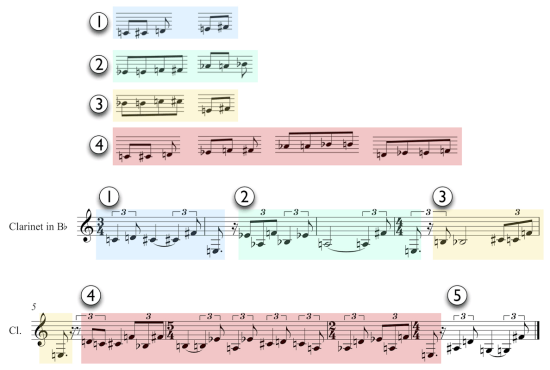
Density Variation
The idea of density variation appears in the Sigle Initial, the section that opens the composition. The spatialisation here is based on the idea of density variation ; that is, the emphasis is placed in the number of speakers active (or not) at any given moment, and not so much the movement of sound in space.
In order to make the idea of density variation more visible, below is a portion of the technical score indicating which speaker(s) are ON and OFF at any given cue. Globally the tendency is very clear : at the beginning of the section the density is one speaker at a time ; while at the end, all the speakers are on. In other words, the recorded clarinet begins by softly darting around the room (one speaker at at a time) and progressively occupies more and more space (speakers) so as to be omni-present at the end.
There is an amusing anecdote here: Pierre Boulez wanted this increasing number of speakers to symbolize the gathering of Luciano Berios friends on the occasion of the premiere of the work dedicated to his sixtieth birthday.

Speakers on and off at each cue in Sigle Initial.
Below is an excerpt of the score from the Sigle Initial. Above the clarinet part - enclosed in small circles - are the cue numbers for each change in spatialisation. Below – enclosed in small rectangles – are the indications for the level changes for each speaker.

Pierre Boulez “Dialogue de l’ombre double” © Copyright 1985 by Universal Edition A.G., Wien/UE 18407
(p)1998 Deutsche Grammophon GmbH, Berlin
© Copyright 1992 by Institut de Recherche et Coordination Acoustique/Musique (IRCAM) Paris (France)
Circular Motion
In Transition III à IV the spatialisation is used to underline the flowing melodic writing which becomes more and more agitated as the section evolves. In order to underline this, the spatialisation proceeds through a slowly accelerating continuous circular motion. The acceleration imitaes the agitation of the clarinet which finishes by stopping on a series of repeated notes which is echoed by the spatialisation by fixing the note to one speaker.
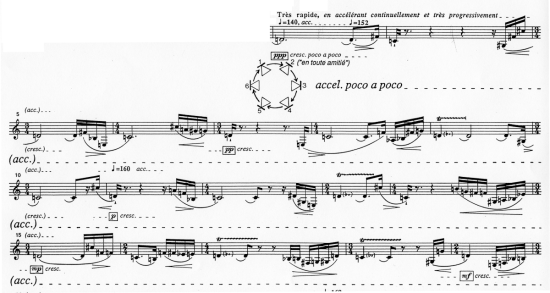
Pierre Boulez “Dialogue de l’ombre double” © Copyright 1985 by Universal Edition A.G., Wien/UE 18407
(p)1998 Deutsche Grammophon GmbH, Berlin
© Copyright 1992 by Institut de Recherche et Coordination Acoustique/Musique (IRCAM) Paris (France)**
Foreground / Background
Two sections of the piece explore the idea of foreground/background : Transition de I à II and Transition de V à VI. Each section explores the idea in a slightly different way.
In Transition de I à II the dynamic level of all six speakers is set to the same realatively soft level. This is the background. The music evolves as a smooth series of trills broken occasionally by one or more grace notes played forte. In order to highlight the abrupt entrance of the grace notes, the level of one or more speakers is suddenly increased. This is the foreground. Once the grace notes are played and the slow trills resume, the level on those speakers goes back to the background level. So the spatialisation serves to separate the slow soft melodic trills from the abrupt grace notes.
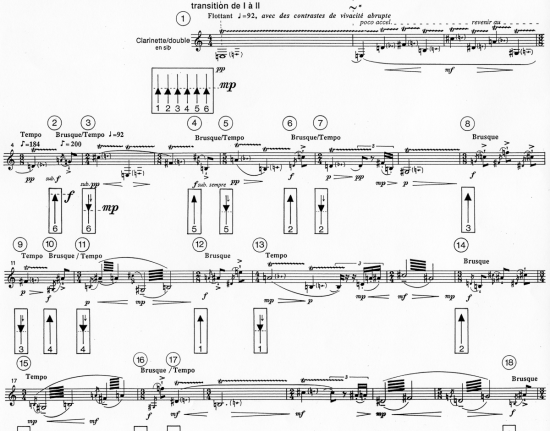
Pierre Boulez “Dialogue de l’ombre double” © Copyright 1985 by Universal Edition A.G., Wien/UE 18407
(p)1998 Deutsche Grammophon GmbH, Berlin
© Copyright 1992 by Institut de Recherche et Coordination Acoustique/Musique (IRCAM) Paris (France)**
In Transition de V à VI we have again a series of slowly evolving tremolos played softly broken by the sudden appearance of a series of grace note figures played forte. Here, as opposed to Transition de I à II, the relatively soft background level is applied only to a small number of speakers at any given time. At each appearance of the grace notes however, all speakers suddenly jump to the forte level. Again, the spatialisation is being used to articulate the kinds of musical writing ; in this case the slow tremolos and abrupt grace notes.
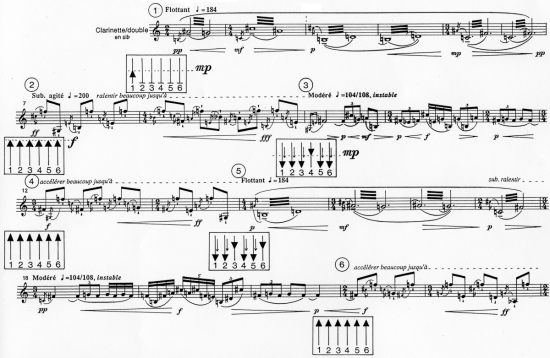
Pierre Boulez “Dialogue de l’ombre double” © Copyright 1985 by Universal Edition A.G., Wien/UE 18407
(p)1998 Deutsche Grammophon GmbH, Berlin
© Copyright 1992 by Institut de Recherche et Coordination Acoustique/Musique (IRCAM) Paris (France)**
Sound example corresponding to score excerpt above.
Zig-Zag
The writing in section Transition IV à V is characterized by a series of short abrupt phrases. They are like short bursts. In order to highlight this aspect, each phrase is projected onto a new speaker each time following an irregular path.
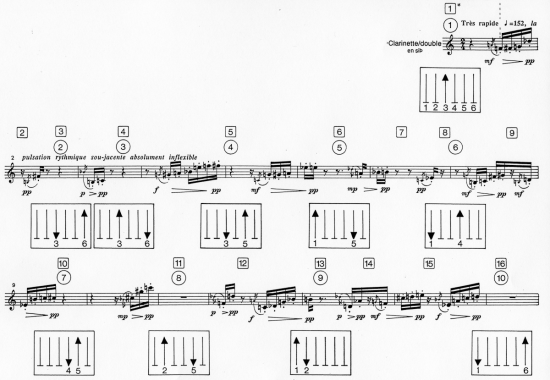
Pierre Boulez “Dialogue de l’ombre double” © Copyright 1985 by Universal Edition A.G., Wien/UE 18407
(p)1998 Deutsche Grammophon GmbH, Berlin
© Copyright 1992 by Institut de Recherche et Coordination Acoustique/Musique (IRCAM) Paris (France)**
The Use of Reverberation
One of the simplest ways of giving the sense of space to a sound is to reverberate it more (sounds “far”) or less (sounds “near”). In Dialogue … this is achieved by varying the proportions of the “near” (0.8 to 1.5 meters) and “far” (5.5 meters) microphone recording levels in making the pre-recorded clarinet parts.
Sigle Initial uses only the near microphone (at 0.8 meters) with no reverberation.
Transition I à II, Transition III à IV and Transition V à VI use only the near microphone (1.5 meters) with a reverberation time of 1.8 – 2.0 seconds.
Transition II à III uses both the near (1.5 meters) and far (5.5 meters). The latter is sent to the reverberator with the time set to 1.8 – 2.0. Predominance is given to the far microphone in order to make the clarinet sound very distant.
Sigle Final uses both the near and far microphones plus reverberation. During this section the proportion between the two vary in such a way that at the beginning the clarinet sounds near at the end sounds distant.
Transition IV à V uses the piano reverberation described earlier. The purpose is to create and capture the resonances provoked by exciting the piano strings (with blocked pedal) via the clarinet sounds.
There is one other place where the piano reverberation is used and that is in Strophe III where the clarinet plays live.
(p)1998 Deutsche Grammophon GmbH, Berlin
L’enregistrement de l’œuvre est disponible en intégralité chez Deutsche Grammophon : .
References
More on the work “Dialogue …” in
More on Pierre Boulez
Score : edited by Universal Edition under the number UE 18407.
Recording : Dialogue de l’ombre double (with Répons) - DGG 457 6052 - 20/21 Series, 1998 :
Forum IRCAM spatialisation technologies